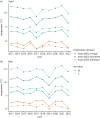Complex relationships between climate and reproduction in a resident montane bird
- PMID: 37351489
- PMCID: PMC10282579
- DOI: 10.1098/rsos.230554
Complex relationships between climate and reproduction in a resident montane bird
Abstract
Animals use climate-related environmental cues to fine-tune breeding timing and investment to match peak food availability. In birds, spring temperature is a commonly documented cue used to initiate breeding, but with global climate change, organisms are experiencing both directional changes in ambient temperatures and extreme year-to-year precipitation fluctuations. Montane environments exhibit complex climate patterns where temperatures and precipitation change along elevational gradients, and where exacerbated annual variation in precipitation has resulted in extreme swings between heavy snow and drought. We used 10 years of data to investigate how annual variation in climatic conditions is associated with differences in breeding phenology and reproductive performance in resident mountain chickadees (Poecile gambeli) at two elevations in the northern Sierra Nevada mountains, USA. Variation in spring temperature was not associated with differences in breeding phenology across elevations in our system. Greater snow accumulation was associated with later breeding initiation at high, but not low, elevation. Brood size was reduced under drought, but only at low elevation. Our data suggest complex relationships between climate and avian reproduction and point to autumn climate as important for reproductive performance, likely via its effect on phenology and abundance of invertebrates.
Keywords: climate; environmental cues; long-term study; phenology; reproductive performance.
© 2023 The Authors.
Conflict of interest statement
We declare we have no competing interests.
Figures





Similar articles
-
Relative breeding timing and reproductive success of a resident montane bird species.R Soc Open Sci. 2024 Jul 17;11(7):240769. doi: 10.1098/rsos.240769. eCollection 2024 Jul. R Soc Open Sci. 2024. PMID: 39156660 Free PMC article.
-
Fluctuations in annual climatic extremes are associated with reproductive variation in resident mountain chickadees.R Soc Open Sci. 2018 May 9;5(5):171604. doi: 10.1098/rsos.171604. eCollection 2018 May. R Soc Open Sci. 2018. PMID: 29892360 Free PMC article.
-
Phenology and productivity in a montane bird assemblage: Trends and responses to elevation and climate variation.Glob Chang Biol. 2019 Mar;25(3):985-996. doi: 10.1111/gcb.14538. Epub 2019 Jan 11. Glob Chang Biol. 2019. PMID: 30506620
-
Patterns and drivers of intraspecific variation in avian life history along elevational gradients: a meta-analysis.Biol Rev Camb Philos Soc. 2016 May;91(2):469-82. doi: 10.1111/brv.12180. Epub 2015 Mar 12. Biol Rev Camb Philos Soc. 2016. PMID: 25765584 Review.
-
Phenological and elevational shifts of plants, animals and fungi under climate change in the European Alps.Biol Rev Camb Philos Soc. 2021 Oct;96(5):1816-1835. doi: 10.1111/brv.12727. Epub 2021 Apr 27. Biol Rev Camb Philos Soc. 2021. PMID: 33908168 Review.
Cited by
-
Distribution of euptyctimous mite Phthiracarus longulus (Acari: Oribatida) under future climate change in the Palearctic.Sci Rep. 2024 Sep 19;14(1):21913. doi: 10.1038/s41598-024-72852-8. Sci Rep. 2024. PMID: 39300195 Free PMC article.
-
Small scale, elevation- and environmental-related differences in life history strategies in a temperate resident songbird.R Soc Open Sci. 2025 Apr 2;12(4):241777. doi: 10.1098/rsos.241777. eCollection 2025 Apr. R Soc Open Sci. 2025. PMID: 40177098 Free PMC article.
-
A long-term study on the impact of climatic variables on two common nest-dwelling ectoparasites of the Eurasian blue tit (Cyanistes caeruleus).Integr Zool. 2025 Mar;20(2):224-235. doi: 10.1111/1749-4877.12834. Epub 2024 May 9. Integr Zool. 2025. PMID: 38724456 Free PMC article.
-
Relative breeding timing and reproductive success of a resident montane bird species.R Soc Open Sci. 2024 Jul 17;11(7):240769. doi: 10.1098/rsos.240769. eCollection 2024 Jul. R Soc Open Sci. 2024. PMID: 39156660 Free PMC article.
References
-
- Møller AP, Fiedler W, Berthold P. 2010. Effects of climate change on birds. Oxford, UK: Oxford University Press.
-
- Visser ME, Both C, Lambrechts MM. 2004. Global climate change leads to mistimed avian reproduction. Adv. Ecol. Res. 35, 89-110.
-
- Rowan W. 1925. Relation of light to bird migration and developmental changes. Nature 115, 494-495. (10.1038/115494b0) - DOI
Associated data
LinkOut - more resources
Full Text Sources

